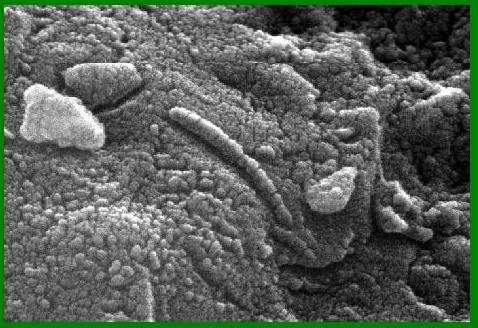 Lesson 7:
Lesson 7:
 Life in the Solar System
Life in the Solar System
|
 7.4
7.4
 From Mars with Love: Mars Meteorite ALH 84001
From Mars with Love: Mars Meteorite ALH 84001
|
|
Figure 7.4.1 Martian meteorites.
Martian meteorites.
|
Mars has sent a letter to Earth, by meteorite mail, reporting on
conditions on that planet. It is perhaps to be expected that the
message is not easily read: after all, it is from a strange place.
The mailbox was the Antarctic ice, a good choice. Whatever arrives in
this place is easily recognized as not from the Earth. Furthermore,
collection has only started recently. The area has not been picked over by stone age people
eager for metallic rocks or, more recently, by souvenir hunters.
The particular rock in question, labeled ALH84001, was recognized as a missive from Mars by
its composition. It is similar to that of a class of meteorites known as
SNC which are assigned to a Martian origin on the basis of gas inclusions resembling the
atmosphere of Mars. Also, these types of meteorites are much younger than the ones derived from
the ancient solar system debris floating about in space.

|
 |
Figure 7.4.2 Meteorite ALH 84001
Meteorite ALH 84001
|
ALH 84001 was not recognized as a Martian sample until 1994, when it was
re-typed as a probable "Martian" meteorite. Its ancient crystallization age sets it
apart from the class of Martian meteorites as whole, and its short space exposure set
it apart from most asteroidal meteorites. The most reliable criterion is a certain
distribution of oxygen isotopes in its minerals, which completely
different from that of any other class of meteorites or of any other
object yet known in our solar system, with the exception of
meteorites from Mars.
The reason ALH84001 became internationally famous (and was written up in
the newspapers) was not the fact that it came from Mars (although
this is remarkable in itself). The reason is that it contains
something that looks like a fossil (sort of).

|
 |
Figure 7.4.3 Electron micrograph of Martian meteorite
Electron micrograph of Martian meteorite
ALH 84001. Elongated structure at center is similar to
bacterial fossils found in Earth rocks. This meteorite
was also the first found to contain organic compunds.
It is not known if these were produced by inorganic
means or by living microorganisms.
|
The finding was announced to a startled world in 1996 by a group of NASA scientists.
The "simplest explanation" for the features seen was said to be that these were indeed
fossils of tiny Martian organisms. Other scientists in exobiology and related fields
have hotly contested this hypothesis. We summarize in the exhibit at:
http://exobio.ucsd.edu/Space_Sciences/lifefrom.htm
the results of a NASA/ESO 1999 scientific conference on the subject;
the consensus was that the evidence for life in this or any other
meteorite is far from convincing. Most scientists agree that sample
returns from Mars, especially from subsurface probes in likely
locations are a high priority.
In the course of the conference scientists realized, as a result of the scientific debate, that
arguments were fuzzy. No one had a very precise idea about how we can
tell, from analyzing a rock, whether the presence of Life is
indicated or not. One must look for a property that is characteristic
of living matter and not simply consistent with the presence
of life. Such a characteristic can then be referred to as a "biosignature".
Is the evidence in ALH84001 on the level of a biosignature?
Apparently not. The organic compounds seen can in principle result from abiogenic
processes. In addition, their presence indicates terrestrial
contamination rather than a Martian origin. The association of
sub-microscopic grains of iron compounds enclosed in carbonate
globules is not diagnostic. The fossil-like features are extremely
small; a hundred times smaller than terrestrial bacteria. Although
the existence of such extremely small organisms
cannot be excluded, the small size weakens the case and also opens
the door to a likelihood of mechanical artifacts. The carbonates
present do not look biogenic and there is no conclusive evidence that
they crystallized at a low enough temperature for life forms to
exist.
Thus, alas, there is no convincing evidence for past life in ALH84001. The refutation of the
claim has been the result of the normal scientific process.
Extraordinary claims require extraordinary evidence. The proof here
offered has not passed ordinary inspection.
Of course, the lack of evidence in this particular rock does not imply the absence of life
on Mars, past or present, or weaken any arguments for its presence.
It is clear that there is intense interest in the matter. A program
of robotic spacecraft missions designed to search for ancient life
will be required for definite proof of such life on Mars and
elsewhere.
|





















